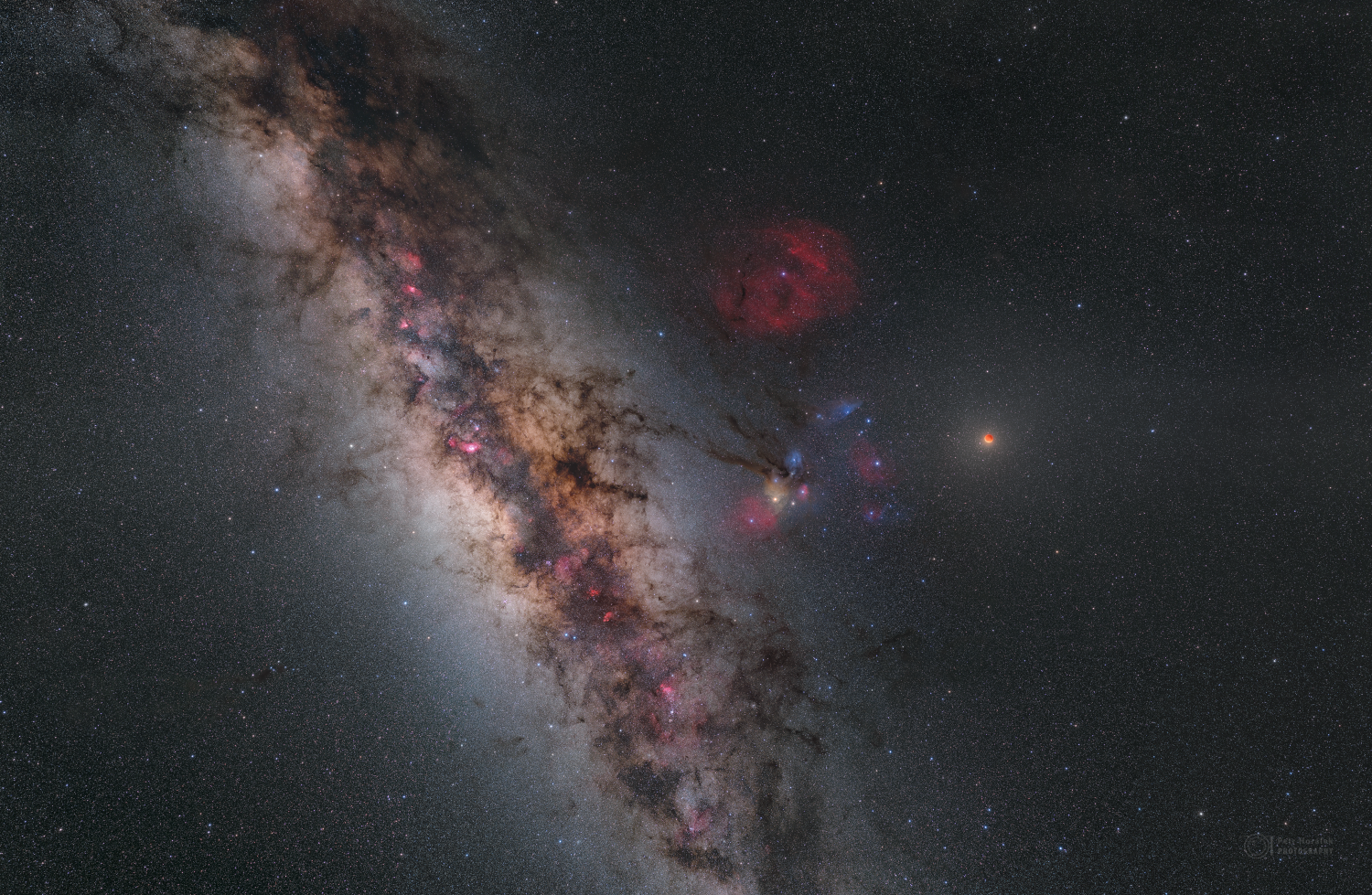 On May 15-16, 2022, a total lunar eclipse occurred, visible primarily over western Europe and the Americas. Located in San Pedro de Atacama, Chile, I had a truly spectacular view of this particular phenomenon nearby the center of the Milky Way in the dark skies (and almost in zenith). Thus it was well possible to realize this deep sky image with the eclipse itself. The eclipsed Moon was extraordinarily dark due to the ash of the Tonga volcano in the Earth’s atmosphere (of the southern hemisphere) and such an HDR image was more possible. Since the totality took only about 85 minutes and the deep imaging of the surrounding of the central Milky Way took more than 12 hours, the foreground was continually captured during nights before the eclipse. Besides the Milky Way and eclipsed Moon, you can also find dark nebulae nearby our Galaxy and the Zodiacal Light with the Gegenschein close by the eclipsed Moon. For the foreground, Canon Ra and Sigma 50mm (f2.8, ISO 6400, 70x30s stacked for a panel of 8 segments of panorama) was used, tracked on Vixen Polarie U. To reveal the Rho Ophiuchi nebulae, I used Astronomik H-alpha and OIII narrowband filters as well, with Canon 6D modified and the same lens (and settings). I would like to acknowledge Tomáš Slovinský and Josef Kujal (of the Astronomy Society of Hradec Králové) for their deep support of this eclipse photography.
On May 15-16, 2022, a total lunar eclipse occurred, visible primarily over western Europe and the Americas. Located in San Pedro de Atacama, Chile, I had a truly spectacular view of this particular phenomenon nearby the center of the Milky Way in the dark skies (and almost in zenith). Thus it was well possible to realize this deep sky image with the eclipse itself. The eclipsed Moon was extraordinarily dark due to the ash of the Tonga volcano in the Earth’s atmosphere (of the southern hemisphere) and such an HDR image was more possible. Since the totality took only about 85 minutes and the deep imaging of the surrounding of the central Milky Way took more than 12 hours, the foreground was continually captured during nights before the eclipse. Besides the Milky Way and eclipsed Moon, you can also find dark nebulae nearby our Galaxy and the Zodiacal Light with the Gegenschein close by the eclipsed Moon. For the foreground, Canon Ra and Sigma 50mm (f2.8, ISO 6400, 70x30s stacked for a panel of 8 segments of panorama) was used, tracked on Vixen Polarie U. To reveal the Rho Ophiuchi nebulae, I used Astronomik H-alpha and OIII narrowband filters as well, with Canon 6D modified and the same lens (and settings). I would like to acknowledge Tomáš Slovinský and Josef Kujal (of the Astronomy Society of Hradec Králové) for their deep support of this eclipse photography.
The view to the central part of our Galaxy is truly spectacularly colorful, at least for cameras. Around the “heart” of Scorpius, the Antares star, are several types of interstellar nebulae, most of them surrounding star Rho of the Ophiuchus constellation in a very close neighborhood. Reddish nebulae are caused by the emission of hydrogen while bluish ones mostly contain dust scattering the light of stars close by. When to the central part of the Milky Way, more emission nebulae can be seen where new stars develop. This beautiful part of the visible close Universe colorfully filled in–viewing from Earth–our Moon during the eclipse.
The total lunar eclipse on May 16th was pretty well expected as it could have been the darkest one after 1992-93 eclipses due to volcanic ash in Earth’s atmosphere, through which part of sunlight gets to the lunar surface. More ash in the atmosphere, darker eclipse we see. Eclipses in 90′ were affected by the Pinatubo eruption, while this year’s one is supposed to be darker because of the Tonga volcano. So I did a photographic investigation using the same exposures during the whole total eclipse (and unifying brightness of the exposures due to changeful clouds coverage during the phenomenon). Overall, the eclipse was not as dark as expected so far, but definitely interesting. As the image shows, the first half (right part) was definitely darker as the volcanic ash was thicker over the Indian and Atlantic Oceans than over the Pacific. Crook or Hook, what a wonderful eclipse it was! Used Canon 6D, MTO 1100, f10.5, ISO 800, 15s exposures (for totality; partial phase is HDR), tracked on Vixen GP-2. The co-author is Josef Kujal of the Astronomical Society in Hradec Kralove.
Enjoy also some wide-angle views taken at Alain Maury’s SPACEOBS astrofarm, where the public observation of the eclipse was scheduled for the entire phenomenon. Even if it was partly cloudy, the view was just so captivating. Used Canon 6D Baaded Modified, Samyang 24mm, f2.2, ISO 10000, 44 single 15s exposures from tripod.
And finally, enjoy the Virtual Tour version of this view:
Before the eclipse, a beautiful moonrise occured over Atacama Desert. Used Canon Ra, Tamron 70-200mm@200mm.














